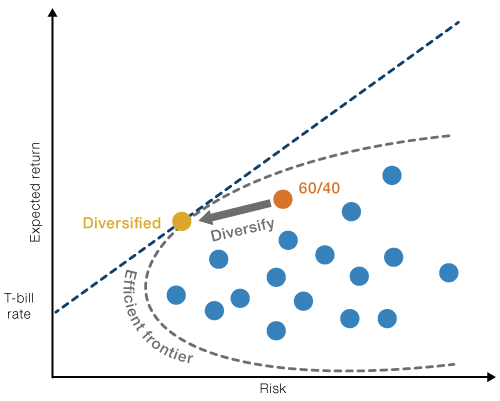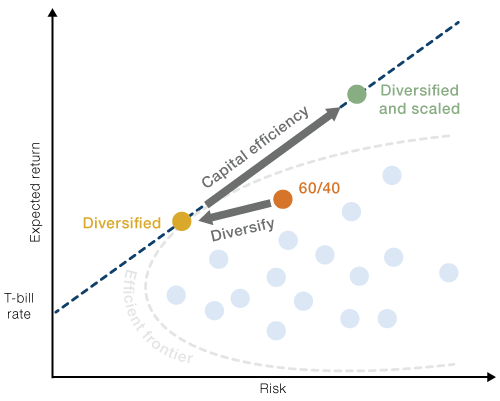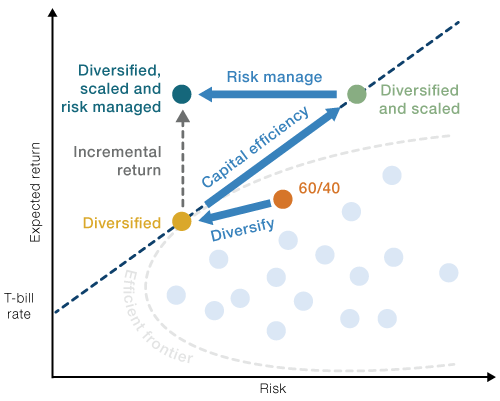Introduction
We are living in times of extreme economic uncertainty: trade wars are raging between the US and China, and South Korea and Japan; political upheaval is rocking markets, from Brexit to the protests in Hong Kong; unprecedented monetary policy experiments, negative rates, inverted yield curves – the list goes on, and on.
In spite of all this, investors may be forgiven for being a little lax. After all, traditional portfolios, consisting of equities and bonds, have generally performed well since the end of the global financial crisis. Stimulus packages have provided fuel to equities and bonds alike, and a negative bond-equity correlation has dampened portfolio-level volatility.
However, we strongly believe that investors should prepare for the uncertainty that lies ahead.
The Z-Shift
First, classic finance 101 insight tells us that diversification can help improve the risk-return potential of a portfolio. The risk in a notional 60/40 stock/bond portfolio is substantially skewed to stocks because of its higher volatility, and hence there is plenty of scope for diversification. Indeed, implicit in the thinking behind a 60/40 notional mix of equities and bonds is the concept of diversification: not only have equities and bonds each had positive returns in the long term, but their returns have also historically displayed a low correlation to each other. To illustrate this, in Figure 1, the different portfolios of available assets are represented by a cloud of points in risk/return space. The 60/40 portfolio is plotted alongside and looks favourable compared with many portfolios because bonds and equities have historically shown attractive risk reward characteristics. However, well-diversified portfolios could potentially be even better, leading to risk-return combinations represented by the so-called efficient frontier. The return on the frontier is higher than any individual asset for a given level of risk. The frontier is also higher than the traditional 60/40 equity/bond portfolio as other asset classes, like credit and inflation-sensitive securities, provide potential diversification benefits.
Figure 1. From 60/40 Equity/Bond to the Diversified Portfolio That Maximises Return/Risk

Source: Man AHL. Schematic illustration. Not intended to represent actual historical performance of any product, portfolio or security.
So, diversifying lowers risk. However, it can also reduce expected returns. So, liquid instruments, such as futures, can scale up the diversified portfolio to try and achieve the desired return. The focus here is on highly liquid instruments for two reasons. First, these instruments can generally be traded on margin or, in other words, in a cash-efficient manner. The second reason is explained in more detail below.
Figure 2. Scaling the Diversified Portfolio to Help Achieve the Desired Expected Return Level

Source: Man AHL. Schematic illustration. Not intended to represent actual historical performance of any product, portfolio or security. Neither diversification nor asset allocation can guarantee a profit or protect against loss in declining markets.
So far, so (theoretically) good. But what can go wrong?
This brings us to our third point: dynamically adapting and managing the risk of the portfolio as needed. There are three categories of risk-mitigating techniques that can be employed, in our view:
- Volatility targeting: aims to counter persistent fluctuations in volatility by dynamically scaling up the portfolio at times of low volatility, and scaling down at times of high volatility;
- Momentum overlays: reduce the exposure to assets that are in a downward trend, i.e., ‘don’t fight the bear market’;
- Bond equity correlation triggers: degear the portfolio when the risk of a bond-driven sell-off increases.
In our view, together, these three techniques aim to reduce the risk while preserving the return target. This is illustrated by the final arrow in Figure 3, and is thus consequently termed the ‘Z-shift’ because of the figure drawn in risk-return space.
For traditional balanced funds, the trading costs of implementing the three risk-mitigating techniques stated above would be high; and is the second reason why we believe to use highly liquid instruments: it becomes possible to trade risk-control tools in a cost-effective manner.
Figure 3. Applying Active Risk Management

Source: Man AHL. Schematic illustration. Not intended to represent actual historical performance of any product, portfolio or security. Neither diversification nor asset allocation can guarantee a profit or protect against loss in declining markets.
Conclusion
In conclusion, we believe this Z-shift – or the use of diversification, capital efficiency (scaling up) and active risk management – can be used to enhance expected returns whilst reducing downside risk. As markets become increasingly difficult to predict, we believe this approach can help investors navigate the uncertainty.
You are now leaving Man Group’s website
You are leaving Man Group’s website and entering a third-party website that is not controlled, maintained, or monitored by Man Group. Man Group is not responsible for the content or availability of the third-party website. By leaving Man Group’s website, you will be subject to the third-party website’s terms, policies and/or notices, including those related to privacy and security, as applicable.